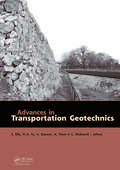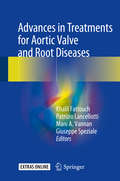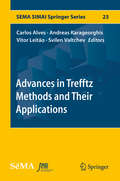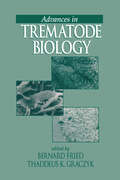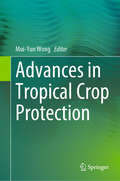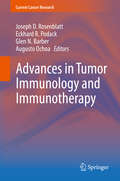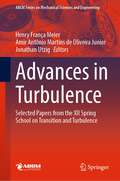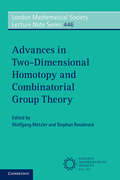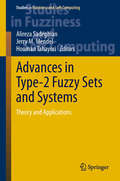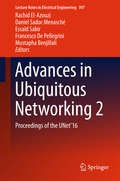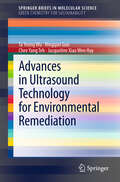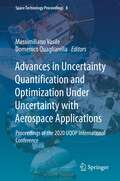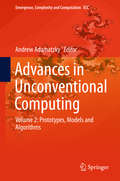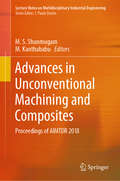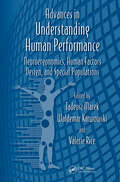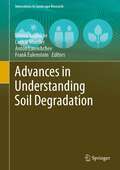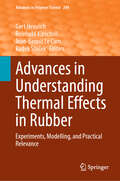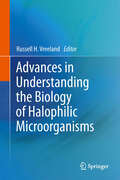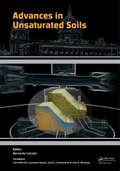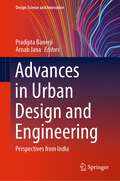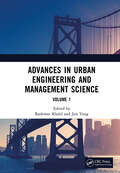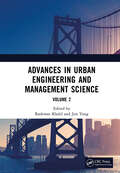- Table View
- List View
Advances in Transportation Geotechnics: Proceedings of the International Conference held in Nottingham, UK, 25-27 August 2008
by Ed Ellis, Hai-SuiYu & Glenn McDowellHighways provide the arteries of modern society. The interaction of road, rail and other transport infrastructure with the ground is unusually intimate, and thus needs to be well-understood to provide economic and reliable infrastructure for society. Challenges include not only the design of new infrastructure (often on problematic ground), but inc
Advances in Treatments for Aortic Valve and Root Diseases
by Khalil Fattouch Patrizio Lancellotti Mani A. Vannan Giuseppe SpezialeThis book describes the different aspects of aortic valve and root diseases including comprehensive discussion of the state-of-the-art diagnostic imaging options, disease risk stratification, selection of candidates for valve repair or percutaneous intervention, and most recent therapeutic options. The growing prevalence of valvular heart disease represents a major challenge in terms of short- and long-term management and surveillance. Aortic valve diseases, including aortic stenosis and regurgitation, are among the most frequent of these, while the number of cases of aortic root disease is also on the rise. Aortic valve disease treatment options include valve surgery, valve repair, minimally invasive valve surgery, and percutaneous approaches and all are covered in this volume.
Advances in Trefftz Methods and Their Applications (SEMA SIMAI Springer Series #23)
by Carlos Alves Andreas Karageorghis Vitor Leitão Svilen ValtchevIn this book we gather recent mathematical developments and engineering applications of Trefftz methods, with particular emphasis on the Method of Fundamental Solutions (MFS). These are true meshless methods that have the advantage of avoiding the need to set up a mesh altogether, and therefore going beyond the reduction of the mesh to a boundary. These Trefftz methods have advantages in several engineering applications, for instance in inverse problems where the domain is unknown and some numerical methods would require a remeshing approach.Trefftz methods are also known to perform very well with regular domains and regular data in boundary value problems, achieving exponential convergence. On the other hand, they may also under certain conditions, exhibit instabilities and lead to ill-conditioned systems. This book is divided into ten chapters that illustrate recent advances in Trefftz methods and their application to engineering problems. The first eight chapters are devoted to the MFS and variants whereas the last two chapters are devoted to related meshless engineering applications. Part of these selected contributions were presented in the 9th International Conference on Trefftz Methods and 5th International Conference on the MFS, held in 2019, July 29-31, in Lisbon, Portugal.
Advances in Trematode Biology
by Bernard Fried Thaddeus K. GraczykTrematodology - the study of a class of medically important parasitic, flat-bodied worms - has made significant advances over the past ten years. The tremendous amount of information accumulated from research discoveries and technical developments related to trematode biology makes this book a timely and necessary part of the literature. Advances in Trematode Biology presents a thorough treatment of modern trematodology, including principles and practices. With coverage of background material as well as modern methods, Advances in Trematode Biology updates researchers, practitioners, and students with new information in immunology, biochemistry, physiology, and molecular biology. Advances in Trematode Biology includes practical information on parasitological techniques, emphasizing species of medical and veterinary importance - a key reference for parasitologists, biologists, medical, and veterinary personnel. The excellent presentation of material, including well-organized tables and chapters, make Advances in Trematode Biology easy to use both as a textbook and as a reference.
Advances in Trichoderma Biology for Agricultural Applications (Fungal Biology)
by Irina S. Druzhinina A. Sankaranarayanan N. Amaresan Mitesh Kumar DwivediAdvances in Trichoderma Biology for Agricultural Applications covers the beneficial properties of Trichoderma in enhancing global agricultural productivity. Trichoderma are biotechnologically significant fungi, being widely used both agriculturally and industrially. In many cases Trichoderma are also a potential drug source of clinical importance. In recent years, driven by advances in genetics and genomics, research on these fungi has opened new avenues for its various applications. This book covers i) Current state of Trichoderma taxonomy, and species identification, ii) Trichoderma and plant-pathogenic fungi interactions, iii) Trichoderma interactions with plants, including rhizosphere competence of Trichoderma, antagonistic potentials, plant growth promotion, and management of various abiotic stresses in plants, iv) Practical aspects of Trichoderma commercialization in agriculture, v) Biosynthesis of metal-based nanoparticles and its application, and vi) Negative impact of Trichoderma strains in the environments.Reading this book should kindle further discussions among researchers working in fungal biotechnology, microbiology, agriculture, environmental science, forestry, and other allied subjects and thus lead to a broader scope of Trichoderma-based products and technologies. The knowledge shared in this book should also provide a warning on the potential risks associated with Trichoderma.
Advances in Tropical Crop Protection
by Mui-Yun WongThis book presents research findings on newly discovered pests and diseases that may be impacted by climate change in the tropics; current management techniques including molecular diagnostics, integrated pest management (IPM), and agroecological approach; and recent technological advancements used as preventive and curative approaches to mitigate the effects of plant pests and diseases. Combining the expertise of leading researchers in the various fields, the book provides a useful reference for all relevant stakeholders. The proposed book is prepared with the aim of disseminating the current research development of emerging pests and diseases in the tropics in the era of climate change as well as new and eco-friendly pest and disease management technologies of tropical crops. The book is divided into three parts with sixteen chapters. Part 1: Advances in Tropical Insect Pest Management consists of five chapters describing the discovery, formulations, and applications of nature-based solutions such as natural enemies of insects, insect hormones, botanicals, and microorganisms for sustainable pest management. Part 2: Advances in Tropical Plant Disease Management consists of seven chapters, describing the causal agents of economically important diseases of tropical crops, rapid pathogen detection systems as well as effective and sustainable disease management strategies. Part 3: Advances in Other Tropical Pests Management consists of four chapters detailing the various eco-friendly pest management of vertebrates, mollusks, weeds, and emerging IR4.0 technologies in pest management. Ideas for future volumes on this subject: Volume II would be a follow-up to Volume I. It covers emerging pests and diseases of the tropics in greater depth, with a focus on specific hosts and diseases. Robust pests and disease management technologies utilized in crop protection in tropical areas by the farmers will be discussed as well.
Advances in Tumor Immunology and Immunotherapy (Current Cancer Research)
by Joseph D. Rosenblatt Eckhard R. Podack Glen N. Barber Augusto OchoaRecent advances in understanding of fundamental immunology have created new insights into the dynamic interactions between tumors and the immune system. This includes new understanding of T- and B-cell interaction, immune inhibitory mechanisms including the biology of T regulatory cells, myeloid suppressor cells, and dendritic cell subsets. Enhanced understanding of mechanisms underlying T-cell anergy such as arginine deprivation, immunosuppressive cytokines, defective innate and interferon response pathways, and NKG2D downregulation have all provided new insight into suppression of anti-tumor immunity and tumor evasion. In addition to emerging understanding of tumor evasion, new immune targets such as CTLA4 blockade, NK stimulatory receptors, manipulation of the antigen processing and presentation, cytokine and costimulatory responses all provide new possibilities for enhancing anti-tumor immunity even in tumors previously felt to be resistant to immune attack. Several of these strategies have already been realized in the clinic. The volume will explore evolving paradigms in antigen presentation, dendritic cell biology, the innate response and immunosuppressive mechanisms, and emerging strategies for manipulation of the immune system for therapeutic benefit that have realized success in neuroblastoma, leukemia, melanoma, lung cancer, and allogeneic transplantation. Early successes as well as failures will be highlighted to provide a snapshot of the state of clinical immunotherapy with an eye to future possibilities such as combination therapies, adoptive T-cell transfer, and the retargeting of immune cells via T-cell receptor engineering.
Advances in Turbulence: Selected Papers from the XII Spring School on Transition and Turbulence (Lecture Notes in Mechanical Engineering)
by Henry França Meier Amir Antônio Martins de Oliveira Junior Jonathan UtzigThis book presents selected papers from the 12th edition of the Spring School of Transition and Turbulence which took place in 2020. The papers cover applications on a number of industrial processes, such as the automotive, aeronautics, chemicals, oil and gas, food, nanotechnology, and others. The readers find out research and applied works on the topics of aerodynamics, computational fluid dynamics, instrumentation and experiments, multi-phase flows, and theoretical and analytical modeling.
Advances in Two-Dimensional Homotopy and Combinatorial Group Theory (London Mathematical Society Lecture Note Series #446)
by Wolfgang Metzler Stephan RosebrockThis volume presents the current state of knowledge in all aspects of two-dimensional homotopy theory. Building on the foundations laid a quarter of a century ago in the volume Two-dimensional Homotopy and Combinatorial Group Theory (LMS 197), the editors here bring together much remarkable progress that has been obtained in the intervening years. And while the fundamental open questions, such as the Andrews-Curtis Conjecture and the Whitehead asphericity problem remain to be (fully) solved, this book will provide both students and experts with an overview of the state of the art and work in progress. Ample references are included to the LMS 197 volume, as well as a comprehensive bibliography bringing matters entirely up to date.
Advances in Type-2 Fuzzy Sets and Systems: Theory and Applications (Studies in Fuzziness and Soft Computing #301)
by Jerry Mendel Alireza Sadeghian Hooman TahayoriThis book explores recent developments in the theoretical foundations and novel applications of general and interval type-2 fuzzy sets and systems, including: algebraic properties of type-2 fuzzy sets, geometric-based definition of type-2 fuzzy set operators, generalizations of the continuous KM algorithm, adaptiveness and novelty of interval type-2 fuzzy logic controllers, relations between conceptual spaces and type-2 fuzzy sets, type-2 fuzzy logic systems versus perceptual computers; modeling human perception of real world concepts with type-2 fuzzy sets, different methods for generating membership functions of interval and general type-2 fuzzy sets, and applications of interval type-2 fuzzy sets to control, machine tooling, image processing and diet. The applications demonstrate the appropriateness of using type-2 fuzzy sets and systems in real world problems that are characterized by different degrees of uncertainty.
Advances in Ubiquitous Networking 2: Proceedings of the UNet’16 (Lecture Notes in Electrical Engineering #397)
by Francesco De Pellegrini Rachid El-Azouzi Essaïd Sabir Mustapha Benjillali Daniel Sadoc MenaschéThis volume offers the proceedings of the 2nd UNet conference, held in Casablanca May 30 - June 1, 2016. It presents new trends and findings in hot topics related to ubiquitous computing/networking, covered in three tracks and three special sessions: Main Track 1: Context-Awareness and Autonomy Paradigms Track Main Track 2: Mobile Edge Networking and Virtualization Track Main Track 3: Enablers, Challenges and Applications Special Session 1: Smart Cities and Urban Informatics for Sustainable Development Special Session 2: Unmanned Aerial Vehicles From Theory to Applications Special Session 3: From Data to Knowledge: Big Data applications and solutions
Advances in Ultrasound Technology for Environmental Remediation (SpringerBriefs in Molecular Science)
by Ningqun Guo Ta Yeong Wu Jacqueline Xiao Hay Chee Yang TehOver the past ten years, innovative technologies have shown that advanced oxidation processes are highly promising when applied to the remediation of polluted water or wastewater as they don't generate any sludge or solid material of hazardous nature. Advances in Ultrasound Technology for Environmental Remediation reviews the fundamentals of ultrasound technology and the state of the art developments in "ultrasound-based free radical generation" in environmental remediation and pollution prevention. It also presents the challenges of introducing ultrasound technology into large-scale environmental remediation applications and examines the methods used to improve ultrasound technology. Indeed, ultrasonic systems are extremely sensitive and vulnerable to operational parameters which cannot be controlled without a good knowledge and understanding of physical and chemical phenomena. Advances in Ultrasound Technology for Environmental Remediation features the theory and fundamentals of ultrasound technology and discusses its potential as an alternative method in environmental remediation.
Advances in Uncertainty Quantification and Optimization Under Uncertainty with Aerospace Applications: Proceedings of the 2020 UQOP International Conference (Space Technology Proceedings #8)
by Massimiliano Vasile Domenico QuagliarellaThe 2020 International Conference on Uncertainty Quantification & Optimization gathered together internationally renowned researchers in the fields of optimization and uncertainty quantification. The resulting proceedings cover all related aspects of computational uncertainty management and optimization, with particular emphasis on aerospace engineering problems. The book contributions are organized under four major themes: Applications of Uncertainty in Aerospace & EngineeringImprecise Probability, Theory and ApplicationsRobust and Reliability-Based Design Optimisation in Aerospace EngineeringUncertainty Quantification, Identification and Calibration in Aerospace Models This proceedings volume is useful across disciplines, as it brings the expertise of theoretical and application researchers together in a unified framework.
Advances in Unconventional Computing: Volume 2: Prototypes, Models and Algorithms (Emergence, Complexity and Computation #23)
by Andrew AdamatzkyThe unconventional computing is a niche for interdisciplinary science, cross-bred of computer science, physics, mathematics, chemistry, electronic engineering, biology, material science and nanotechnology. The aims of this book are to uncover and exploit principles and mechanisms of information processing in and functional properties of physical, chemical and living systems to develop efficient algorithms, design optimal architectures and manufacture working prototypes of future and emergent computing devices. This first volume presents theoretical foundations of the future and emergent computing paradigms and architectures. The topics covered are computability, (non-)universality and complexity of computation; physics of computation, analog and quantum computing; reversible and asynchronous devices; cellular automata and other mathematical machines; P-systems and cellular computing; infinity and spatial computation; chemical and reservoir computing. The book is the encyclopedia, the first ever complete authoritative account, of the theoretical and experimental findings in the unconventional computing written by the world leaders in the field. All chapters are self-contains, no specialist background is required to appreciate ideas, findings, constructs and designs presented. This treatise in unconventional computing appeals to readers from all walks of life, from high-school pupils to university professors, from mathematicians, computers scientists and engineers to chemists and biologists.
Advances in Unconventional Machining and Composites: Proceedings of AIMTDR 2018 (Lecture Notes on Multidisciplinary Industrial Engineering)
by M. S. Shunmugam M. KanthababuThis volume presents research papers on unconventional machining (also known as non-traditional machining and advanced manufacturing) and composites which were presented during the 7th International and 28th All India Manufacturing Technology, Design and Research conference 2018 (AIMTDR 2018). The volume discusses improvements on well-established unconventional machining processes and novel or hybrid machining processes as well as properties, fabrication techniques and machining of composite materials. This volume will be of interest to academicians, researchers, and practicing engineers alike.
Advances in Understanding Human Performance: Neuroergonomics, Human Factors Design, and Special Populations (Advances in Human Factors and Ergonomics Series)
by Waldemar Karwowski Tadeusz Marek Valerie RiceCombining emerging concepts, theories, and applications of human factors knowledge, this volume focuses on discovery and understanding of human performance issues in complex systems, including recent advances in neural basis of human behavior at work (i.e. neuroergonomics), training, and universal design. The book is organized into ten sections tha
Advances in Understanding Kingella kingae (SpringerBriefs in Immunology)
by Joseph W. St. GemeThis book describes the growing body of information on the epidemiology, clinical manifestations, transmission, pathogenesis, diagnosis, and treatment of Kingella kingae infections in young children. In addition, it covers experimental methods that have been developed to study the microbiology, genetics, and virulence factors of K. kingae, information that provides the foundation for new approaches to treatment and prevention of K. kingae disease. With this content in mind, excerpts from the book will be of relevance for clinicians who care for pediatric patients, for clinical microbiologists who are involved in detecting organisms in clinical specimens, and for scientists who are studying K. kingae in an effort to develop novel targets for antimicrobial therapy and new approaches to prevention. First isolated in the 1960s by Elizabeth O. King, a bacteriologist at the CDC, Kingella kingae was largely ignored over the next two decades as a human pathogen because of its uncommon recovery from patients with disease. However, in recent years K. kingae has been increasingly recognized as a clinically important pathogen in young children, and is currently recognized as the leading cause of osteoarticular infections in young children in a growing number of countries. Research into this organism has grown tremendously over the past 15 years, resulting in a better appreciation of the importance of K. kingae in pediatric patients and of the molecular mechanisms of disease.
Advances in Understanding Soil Degradation (Innovations in Landscape Research)
by Lothar Mueller Frank Eulenstein Elmira Saljnikov Anton LavrishchevThis book informs about knowledge gain in soil and land degradation to reduce or prevent it for meeting the mission of the Sustainable Developments Goals of the United Nations. Essence, extent, monitoring methods and implications for ecosystem functioning of main soil degradation types are characterized in overview chapters and case studies. Challenges, approaches and data towards identification of degradation in the frame of improving functionality, health and multiple ecosystem services of soil are demonstrated in the studies of international expert teams. The book consists of five parts, containing 5–12 single chapters each and 36 in total. Parts are explaining (I) Concepts and Indicators, (II) Soil Erosion and Compaction, (III) Soil Contamination, (IV) Soil Carbon and Fertility Monitoring and (V) Soil Survey and Mapping of Degradation The primary audience of this book are scientists of different disciplines, decision-makers, farmers and further informed people dealing with sustainable management of soil and land.
Advances in Understanding Thermal Effects in Rubber: Experiments, Modelling, and Practical Relevance (Advances in Polymer Science #294)
by Gert Heinrich Reinhold Kipscholl Radek Stoček Jean-Benoît Le CamIn the case of an ideal rubber, one often thinks of the linear dependence of the shear modulus on temperature as an expression of the typical entropy elasticity. However, temperature dependencies of typical technical rubber materials are known to be much more complicated. This has consequences for the practical behaviour of rubber-elastic components. One well-known instance of this is the dramatic Challenger disaster. The rubber used to seal the solid rocket booster joints with O-rings did not expand at temperatures of 0 °C or below, resulting in an opening in the solid rocket booster joint through which gas attempted to escape. The main physical reason for the heat generation processes is the hysteresis of rubber materials due to deformation and viscoelasticity. Most elastomers therefore change significantly over time when exposed to heat (and likewise light or oxygen (ozone)). These changes can have a dramatic effect on the life and properties of the elastomers. Heat development in a rubber occurs when it is subjected to a variety of compressive stresses in service. Heat evolution tests are commonly performed to estimate the quality of use and expected service life of various compounds or material options for end-product applications. New developments in recent years on test methods in this direction constitute an important part of the book. At the same time, corresponding simulation and modelling methods have been developed that contribute to a better understanding and enable the predictive simulation of self-heating and the kinetics of temperature fields in complex cyclically loaded rubber components. Specifically, finite-strain thermal viscoelastic damage models for predicting the cyclic thermomechanical response of rubber specimens under fatigue are also presented, and analytical models for heat diffusion in stressed rubbers.
Advances in Understanding the Biology of Halophilic Microorganisms
by Russell H. VreelandThis book is designed to be a long term career reference. The chapters present modern procedures. This is a how-to-book with a difference. These chapters: - reveal the background information about working with salt loving organisms, - are loaded with information about how experiments are conducted under high salt, - provide information about analyses that work under these conditions and those that may not, - present a wide range of details from laboratory designs to equipment used and even to simple anecdotal hints that can only come from experience. Microbiological training focuses largely on the growth, the handling and the study of the microbes associated with humans and animals. Yet the largest proportion of the Earth's microbiota lives in saline environments such as the Oceans, saline deserts and terminal hypersaline environments. This need for salt can be intimidating for those interested in entering the field or for those interested in understanding how such research is accomplished.
Advances in Unsaturated Soils
by Bernardo Caicedo Laureano Hoyos Carol Murillo Julio Esteban Colmenares Iván Rafael BerdugoNew theories and testing techniques related with Unsaturated Soil Mechanics have proven to be valuable tools to study a broad spectrum of geo-materials which includes rocks, rock fills, frozen soils and domiciliary solid wastes. These new theories and testing techniques have permitted the analysis of several traditional problems from a new perspect
Advances in Urban Construction and Management Engineering: Proceedings of the 3rd International Conference on Urban Construction and Management Engineering (ICUCME 2022), Guangzhou, China, 22–24 July 2022
by Young-Jin ChaAdvances in Urban Construction and Management Engineering focuses on the research of urban traffic, city engineering, ecological city and management engineering. The proceedings feature the most cutting-edge research directions and achievements related to Urban Construction. Subjects in the proceedings include: • Urban development and construction• Architectural design and urban planning• Logistics and supply chain management• Management engineering The works of this proceedings can promote development of Urban Construction and Management Engineering, resource sharing, flexibility and high efficiency. Thereby, promote scientific information interchange between scholars from the top universities, research centers and high-tech enterprises working all around the world.
Advances in Urban Design and Engineering: Perspectives from India (Design Science and Innovation)
by Arnab Jana Pradipta BanerjiThis volume discusses a combination of topics dealing with the wide variety of urban planning, authored by well reputed scholars in India mastering disciplines such as architecture, urban design, transportation planning, public policy, urban planning, urban engineering and civil engineering. It focuses on contemporary problems in metro cities like New Delhi, Ahmedabad, Mumbai, etc. This book also highlights critical aspects of urban developments while considering the aspects of mega infrastructure projects especially related to water, waste water treatment and environmental issues.
Advances in Urban Engineering and Management Science Volume 1: Proceedings of the 3rd International Conference on Urban Engineering and Management Science (ICUEMS 2022), Wuhan, China, 21-23 January 2022
by Jun Yang Rashwan KhalilAdvances in Urban Engineering and Management Science contains the selected papers resulting from the 2022 3rd International Conference on Urban Engineering and Management Science (ICUEMS 2022). Covering a wide range of topics, the Proceedings of ICUEMS 2022 presents the latest developments in: (i) Architecture and Urban Planning (Architectural design and its theory, Urban planning and design, Building technology science, Urban protection and regeneration, Urban development strategy, Ecological construction and intelligent control, Sustainable infrastructure); (ii) Logistics and supply chain management (Warehousing and distribution, Logistics outsourcing, Logistics automation, Production and material flow, Supply chain management technology, Supply chain risk management, Global service supply chain management, Supply Chain Planning and Inventory Management, Coordination and collaboration of supply chain networks, Governance and regulatory aspects affecting supply chain management); (iii) Urban traffic management (Smart grid management, Belt and Road Development, Intelligent traffic analysis and planning management, Big data and transportation management).The Proceedings of ICUEMS 2022 will be useful to professionals, academics, and Ph.D. students interested in the above-mentioned fields. Emphasis was put on basic methodologies, scientific development and engineering applications. ICUEMS 2022 is to provide a platform for experts, scholars, engineers and technical researchers engaged in the related fields of urban engineering management to share scientific research achievements and cutting-edge technologies, understand academic development trends, broaden research ideas, strengthen academic research and discussion, and promote the industrialization cooperation of academic achievements. Experts, scholars, business people and other relevant personnel from universities and research institutions at home and abroad are cordially invited to attend and exchange.
Advances in Urban Engineering and Management Science Volume 2: Proceedings of the 3rd International Conference on Urban Engineering and Management Science (ICUEMS 2022), Wuhan, China, 21-23 January 2022
by Jun Yang Rashwan KhalilAdvances in Urban Engineering and Management Science contains the selected papers resulting from the 2022 3rd International Conference on Urban Engineering and Management Science (ICUEMS 2022). Covering a wide range of topics, the Proceedings of ICUEMS 2022 presents the latest developments in: (i) Architecture and Urban Planning (Architectural design and its theory, Urban planning and design, Building technology science, Urban protection and regeneration, Urban development strategy, Ecological construction and intelligent control, Sustainable infrastructure); (ii) Logistics and supply chain management (Warehousing and distribution, Logistics outsourcing, Logistics automation, Production and material flow, Supply chain management technology, Supply chain risk management, Global service supply chain management, Supply Chain Planning and Inventory Management, Coordination and collaboration of supply chain networks, Governance and regulatory aspects affecting supply chain management); (iii) Urban traffic management (Smart grid management, Belt and Road Development, Intelligent traffic analysis and planning management, Big data and transportation management). The Proceedings of ICUEMS 2022 will be useful to professionals, academics, and Ph.D. students interested in the above-mentioned fields. Emphasis was put on basic methodologies, scientific development and engineering applications. ICUEMS 2022 is to provide a platform for experts, scholars, engineers and technical researchers engaged in the related fields of urban engineering management to share scientific research achievements and cutting-edge technologies, understand academic development trends, broaden research ideas, strengthen academic research and discussion, and promote the industrialization cooperation of academic achievements. Experts, scholars, business people and other relevant personnel from universities and research institutions at home and abroad are cordially invited to attend and exchange.
